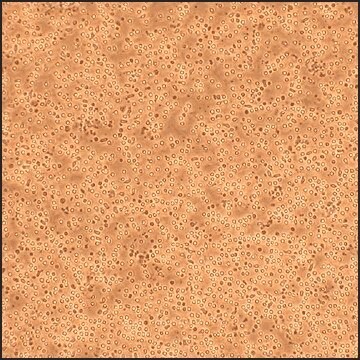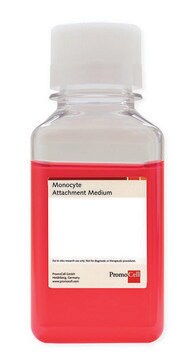C-12907
Human Mononuclear Cells (hMNC)
Isolated from peripheral blood, single donor, ultra-pure, 25 million cryopreserved cells
Synonim(y):
hMNC cells
About This Item
Polecane produkty
pochodzenie biologiczne
human peripheral blood
opakowanie
pkg of 25,000,000 cells
morfologia
(mononuclear)
metody
cell culture | mammalian: suitable
Warunki transportu
dry ice
temp. przechowywania
−196°C
Powiązane kategorie
Opis ogólny
Pochodzenie linii komórkowej
Zastosowanie
Jakość
Ostrzeżenie
Rutyna subkultury
Inne uwagi
Oświadczenie o zrzeczeniu się odpowiedzialności
Kod klasy składowania
12 - Non Combustible Liquids
Klasa zagrożenia wodnego (WGK)
WGK 1
Temperatura zapłonu (°F)
Not applicable
Temperatura zapłonu (°C)
Not applicable
Certyfikaty analizy (CoA)
Poszukaj Certyfikaty analizy (CoA), wpisując numer partii/serii produktów. Numery serii i partii można znaleźć na etykiecie produktu po słowach „seria” lub „partia”.
Masz już ten produkt?
Dokumenty związane z niedawno zakupionymi produktami zostały zamieszczone w Bibliotece dokumentów.
Produkty
Mononuclear cells isolated from umbilical cord blood and adult peripheral blood and maintenance medium optimized for short term cultivation. Protocols for handling, cell passaging, media, and product use.
Odkryj ponad 350 produktów PromoCell na Sigma.com, w tym kriokonserwowane komórki krwi i pożywki do hodowli komórkowych dla różnych komórek ludzkich.
Protokoły
Mononuclear cells isolated from umbilical cord blood and adult peripheral blood and maintenance medium optimized for short term cultivation. Protocols for handling, cell passaging, media, and product use.
Nasz zespół naukowców ma doświadczenie we wszystkich obszarach badań, w tym w naukach przyrodniczych, materiałoznawstwie, syntezie chemicznej, chromatografii, analityce i wielu innych dziedzinach.
Skontaktuj się z zespołem ds. pomocy technicznej




